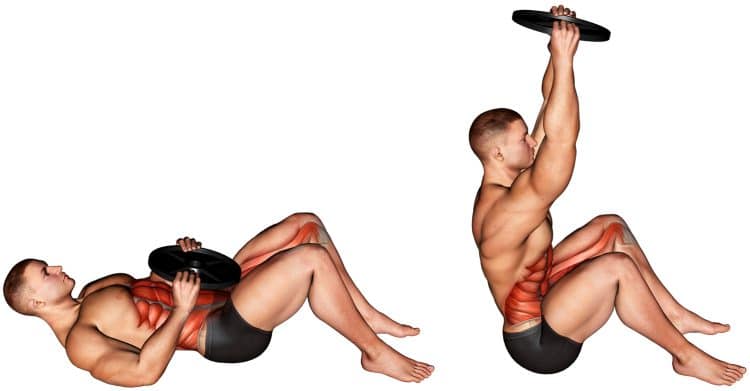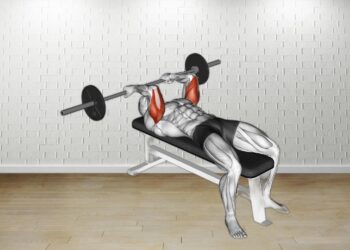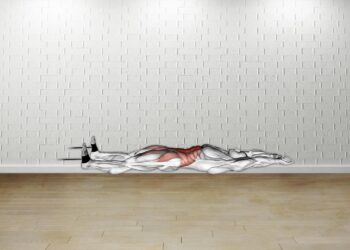You could think of the otis up as a glorified sit-up with added resistance and a challenging workout for the shoulders. We don’t know where it got the unique name but the former is an effective tool for more advanced exercisers that want to build a powerful and resilient midriff.
Check out the full guide below to learn about proper exercise form, benefits, variations, workout tips, and more.
How To Do The Otis Up
Note: We recommend the otis up for more advanced exercisers. Sit ups can be an effective abdominal builder, however, most beginners may not have the core strength to perform them safely and effectively.
Below we’ve included step-by-step instruction and a video demonstration of the otis up.
To do it:
- Lie on your back, knees propped up and feet flat on the floor. While optional, most find it easier to place their feet under a sturdy object (e.g., heavy dumbbells, a couch, exercise machine), or even have someone hold the feet down.
- Grab your weight (plate or dumbbell) in both hands and hold it close to your chest.
- Drive your core down into the floor and sit up as high as you can while pressing the weight overhead toward the ceiling. You can also keep your arms fully extended through the exercises.
- Roll back into the lying position and lower the weight toward your chest.
- Repeat the exercise for the desired number of repetitions.
Watch the video below for a demonstration of the otis up.
Related: Best Weighted Abs Exercises and Workouts
Otis up exercise tips
Here are some tips to help you get the most out of the otis up.
Level Up Your Fitness: Join our 💪 strong community in Fitness Volt Newsletter. Get daily inspiration, expert-backed workouts, nutrition tips, the latest in strength sports, and the support you need to reach your goals. Subscribe for free!
- While most video examples show the legs bent during an otis up, you can make the exercise a lot more challenging by keeping your legs fully extended out in front of you. This removes any assistance from the legs during the movement.
- Feel free to use any weighted object that’s most comfortable for you. Sometimes you can only use what’s available and it doesn’t make a difference. Weight plates, dumbbells, barbells, kettlebells, water jugs, etc can all get the job done.
- Perform each rep with control, ensuring that the core muscles are engaged and active.
- Avoid cheating and using momentum as this can be dangerous and decrease the effectiveness of the movement.
Benefits
Let’s talk about the amazing benefits of the otis up and its variations.
Stronger core and delts
The otis up is a weight-loaded movement unlike bodyweight sit ups that eventually become less challenging as the exerciser gets better at them. There are many options for adding resistance to this exercise and you can train pretty heavy using weight plates, dumbbells and even a loaded barbell for more advanced exercisers.
Aside from building a stronger core, your shoulders will also get a grueling workout.
Better ab development
Muscle growth is the result of progressive overload or lifting more weight over time, performing more repetitions, and combining both methods. Pushing yourself to do better each and every week and having a good nutrition and recovery plan will maximize your core development.
Can be done from almost anywhere
Most people can find a suitable setup to perform otis ups. A bedframe, couch, or anything that you can secure your feet under will do, and who can’t find a small weighted object to add some resistance? If you want to challenge your core and don’t have access to exercise equipment, the otis up is perfect.
Challenge yourself
Training should be challenging both physically and mentally. But that’s what makes it such an overall beneficial activity. Pushing yourself to lift a little heavier or grind through those few extra reps results in changes that make the effort well worth it.
3 Otis Up Variations
Mix up your core training and with these otis up variations.
1. Two dumbbells
Using two dumbbells instead of one makes the exercise a bit more challenging because now you have to focus on maintaining balance between both sides. This helps to improve unilateral (training the limbs independently of each other) strength and core stability.
2. One-arm alternating Otis up
Similar to using two dumbbells, passing the dumbbell back and forth between hands will also challenge your unilateral strength and core stability.
To do it:
- Grab the desired weight and lie on your back with the knees propped up or the legs fully extended on the floor.
- Holding the weight in either hand, press it up above your chest until your arm is fully extended.
- Press your core into the ground and try to lift your torso as high as possible while keeping your arm extended and holding the dumbbell overhead.
- Return to your back and keep the arm fully extended.
- Switch the dumbbell to your other hand and repeat steps 1-4.
- After each rep (sit up and lie down), pass the dumbbell to the other hand and continue alternating until your set is complete.
3. Decline weighted sit up
Decline sit up variations are great because they allow you to get a stretch in the core muscles during the eccentric phase of the movement, and that also means a larger range of motion. This may be beneficial for your abdominal development.
Level Up Your Fitness: Join our 💪 strong community in Fitness Volt Newsletter. Get daily inspiration, expert-backed workouts, nutrition tips, the latest in strength sports, and the support you need to reach your goals. Subscribe for free!
How To Incorporate The Otis Up Into Your Core Training
There are many different ways that you can include the otis up into your workouts. The first and obvious being alongside your other ab exercises during a core training workout. Check out some of our suggestions below.
Core-focused workout
If you’re serious about building a strong, powerful and ripped midriff then you should utilize a variety of movements that emphasize specific parts of the midsection.
These include leg lift variations, crunches, rotational movements for the obliques, isometric holds, and weighted exercises. The otis up emphasizes the rectus abdominis muscles and is an excellent strength builder. Try to incorporate it with the other ab variations.
Circuit training
Pick six to twelve different exercises and run through them with no rest in between… that’s circuit training in a nutshell. It’s one of the best methods for training multiple muscle groups in one session while burning lots of calories and building up your cardiovascular fitness.
The otis up can be a perfect addition to a circuit training workout as it takes very little time to get set up and going.
Also try this ab-focused circuit workout.
Sets/reps
It’s a little more difficult to determine an appropriate set and rep range for bodyweight exercises. While the otis up is a weighted variation, your bodyweight makes up a majority of the resistance used during the exercise. For this reason, we only recommend the weighted otis up for those with a moderate to advanced level of training experience.
The otis up and sit up variations should be performed using proper form and it’s harder to adjust the resistance with bodyweight exercises.
Below we’ve included recommended set and rep ranges for different goals.
- Strength: 3-5 sets x 5-7 reps
- Hypertrophy: 8-15 reps
- Core endurance: 15-25+ reps
Muscles Involved
The otis up is an intense core-building exercise that targets the muscles of the midsection. Below we’ve provided brief descriptions of the muscles worked as well as the muscles involved in this exercise.

Core muscles
Otis ups are a potent core exercise, replicating the function of the abdominal muscles which is to curl the torso up. Adding extra tension to the movement will increase the size of the strength of your abdominals.
Iliopsoas
The iliopsoas are three muscles – psoas major/minor and iliacus – located in the inner hip. It’s the strongest hip flexor also responsible for maintaining the strength and integrity of the hip joint. During Otis ups the hip flexors help to keep the hips in a flexed position.
Pectineous
Part of five larger adductors in the medial thigh, pectineous assists in flexing the hips and medially rotating the thighs inward toward the opposite leg.
Sartorius
Making up the longest muscle in the entire body, sartorius passes through the hip and knee joints, flexing the extremities at both ends. It also externally rotates the hips.
Deltoids
The Otis up could be considered a shoulder exercise as you need to have strength and endurance in your deltoids to support the weight load.
However, out of the three shoulder muscles – anterior (front), lateral (side) and posterior (rear), the anterior may get the most direct stimulation. That’s because its role is to flex the arm forward, a similar movement in Otis ups.
Bottom Line
It doesn’t get much better than the otis up if you’re looking for a simple, yet very challenging core strength building exercise. If you’re tired of sit ups or they’ve become too easy to do, then the otis up is the best way to make them a more challenging core exercise.
Interested in measuring your progress? Check out our strength standards for Sit Ups, Decline Sit Up, Crunches.









